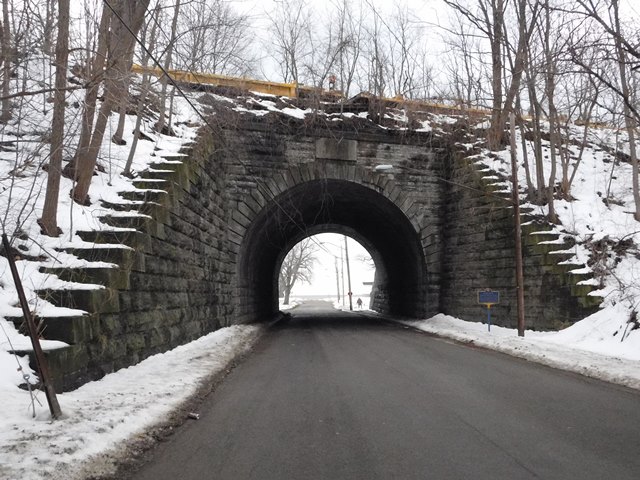We Recommend:
Bach Steel - Experts at historic truss bridge restoration.
BridgeHunter.com Phase 1 is released to the public! - Visit Now
Jackson Street Railroad Overpass
Skew Arch

Primary Photographer(s): Marc Scotti
Bridge Documented: 2018
Silver Creek: Chautauqua County, New York: United States
Not Available or Not Applicable
Not Available
Not Available
Not Available
1 Main Span(s)
Not Applicable

View Information About HSR Ratings
Bridge Documentation
Although widened with concrete on one side, the original portion of this bridge is an exceedingly rare example of a helicoidal arch, the most advanced way to produce a skewed stone arch bridge. Rather than offseting the courses of stone, the simpler and more common way to skew a stone arch, a helicoidal arch had carefully cut stones that allow for a true skew with a smooth arch barrel. This required cutting each stone in the barrel to an exact curve, and as such a bridge like this represents the finest in masonry craftsmanship. Less than 10 helicoidal arch bridges have been identified in the United States. Even in the United Kingdom, where more exist, they are uncommon.
Some period postcards hailed this bridge as "First of Its Kind In America" however this is untrue as earlier examples are found in Pennsylvania dating decades earlier, dating to 1832 and 1857 and a ca. 1846 example is identified in Connecticut.
This bridge still carries 30-40 trains every day.
Above: Historical postcard showing bridge.
Above: Historical postcard showing bridge.
This bridge is tagged with the following special condition(s): Unorganized Photos and Helicoidal Arch
![]()
Photo Galleries and Videos: Jackson Street Railroad Overpass
Unorganized Photos
Original / Full Size PhotosA collection of overview and detail photos, presented as an unorganized and unlabeled collage and gallery. This gallery offers photos in the highest available resolution and file size in a touch-friendly popup viewer.
Alternatively, Browse Without Using Viewer
![]()
Unorganized Photos
Mobile Optimized PhotosA collection of overview and detail photos, presented as an unorganized and unlabeled collage and gallery. This gallery features data-friendly, fast-loading photos in a touch-friendly popup viewer.
Alternatively, Browse Without Using Viewer
![]()
Maps and Links: Jackson Street Railroad Overpass
Coordinates (Latitude, Longitude):
Search For Additional Bridge Listings:
Bridgehunter.com: View listed bridges within 0.5 miles (0.8 kilometers) of this bridge.
Bridgehunter.com: View listed bridges within 10 miles (16 kilometers) of this bridge.
Additional Maps:
Google Streetview (If Available)
GeoHack (Additional Links and Coordinates)
Apple Maps (Via DuckDuckGo Search)
Apple Maps (Apple devices only)
Android: Open Location In Your Map or GPS App
Flickr Gallery (Find Nearby Photos)
Wikimedia Commons (Find Nearby Photos)
Directions Via Sygic For Android
Directions Via Sygic For iOS and Android Dolphin Browser
USGS National Map (United States Only)
Historical USGS Topo Maps (United States Only)
Historic Aerials (United States Only)
CalTopo Maps (United States Only)



